Short-Term Wind Power Prediction Based on MVMD-AVOA-CNN-LSTM-AM
Abstract
Due to the intermittent and fluctuating nature of wind power generation, it is difficult to achieve the desired prediction accuracy for wind power prediction. For this reason, this paper proposes a combined prediction model based on the Pearson correlation coefficient method, multivariate variational mode decomposition (MVMD), African vultures optimization algorithm (AVOA) for leader–follower patterns, convolutional neural network (CNN), long short-term memory (LSTM), and attention mechanism (AM). Firstly, the Pearson correlation coefficient method is used to filter out the meteorological data with a strong relationship with wind power to establish the wind power prediction dataset; subsequently, MVMD is used to decompose the original data into multiple subsequences in order to handle the meteorological data better. Thereafter, the African vultures algorithm is used to optimize the hyperparameters of the CNN-LSTM algorithm, and the AM is added to increase the prediction effect, and the decomposed subsequences are predicted separately, and the predicted values of each subsequence are superimposed to obtain the final prediction value. Finally, the effectiveness of the model is verified using data from a wind farm in Shenyang. The results show that the MAE of the established MVMD-AVA-CNN-LSTM-AM model is 2.0467, and the MSE is 2.8329. Compared with other models, the prediction accuracy is significantly improved, and it had better generalization ability and robustness, and better generalization and robustness.
1. Introduction
In recent years, wind energy has emerged as a new type of renewable energy source that is clean and pollution-free. It can reduce environmental pollution caused by fossil fuels. At the same time, wind energy has become the fastest-growing sustainable energy source in the world because it is economical, convenient, and efficient [1–3]. However, as wind power continues to be connected to the grid, the problems caused by its intermittent and fluctuating nature are gradually becoming more prominent. Accurately predicting wind power can minimize operating costs and improve wind power utilization while ensuring reliability and stability [4–6]. At the same time, accurately predicting wind power also helps with electricity price forecasting [7] and improves the profits of wind power producers [8].
After the research of scholars, there are three commonly used methods for wind power prediction, which are the physical method [9], the statistical method [10], and the machine learning method [11].
The physical method is based on the geographic environment where the wind farms are located, considering the effects of atmospheric mesoscale modeling, to build a mathematical model [12]. Liao et al. [13] modeled the neighboring wind farms and local meteorological factors as a new form of graphs from a graph theoretical point of view, from which spatiotemporal correlations are captured. Physical methods are usually accompanied by huge amounts of data and require supercomputers for computation. This method is suitable for long-term forecasting with unsatisfactory short-term forecasting errors, while it is costly and complex to model [14].
The statistical methods include regression analysis [15], time series method [16], and Kalman filter [17], which builds a prediction model by finding the relationship between numerical weather data and power in wind farms [18], and the prediction results are drastically affected by historical data when using statistical methods. In the actual collection, many data are incomplete or abnormal because of communication failures or sensor problems. While the data are incomplete or abnormal, the prediction accuracy of the statistical method will be significantly and adversely affected. As a result, statistical methods are more straightforward and faster, but their prediction accuracy is limited in many ways.
The machine learning methods do not rely on predefined functional relationships between inputs and outputs. Instead, they leverage artificial intelligence techniques to learn from large volumes of historical data collected from wind farms. Through this process, they identify complex, nonlinear relationships among various weather and environmental factors, turbine conditions, and power output. By utilizing these learning methods, it is possible to predict the power output of different turbines and wind farms without needing to explicitly focus on factors such as the geographical location of the wind farm itself. Machine learning methods for predicting wind power include BPNN [19], SVM [20], and wavelet analysis [21].
At present, it is difficult to achieve good prediction results using a single method. At present, it is more common to use a hybrid of multiple methods to predict wind power. Zhang [22] et al. used CNN-SLTM for wind power prediction, Gao [23] et al. used PCA combined with CNN-GRU for prediction and achieved good results, and Yao [24] et al. used GS-GRU for wind speed prediction, and the results showed that they predicted the wind speed variation well. In order to improve the prediction accuracy, the use of the modal decomposition method to decompose the initial features has become a standard means of the research; Zhou [25] et al. used EMD combined with long short-term memory (LSTM) to predict wind power, Xu [26] et al. used VMD combined with ELM to achieve wind power prediction as well, and Zhang [27] et al. used VMD combined with TCN-BIGRU to predict wind power sufficiently as well. Good wind power prediction was also achieved. To further improve the prediction effect, hybrid models generally introduce heuristic algorithms to optimize the hyperparameters. Wei [28] et al. used IGWO to optimize the hyperparameters of the BP neural network and achieved good results. Xin [29] et al. used the IPSO algorithm to optimize the ELM and further improve the prediction effect. Wang et al. [30] used PSO to optimize the BP neural network and achieved better prediction results.
In this paper, we proposed an MVMD-AVOA-CNN-LSTM-AM model for wind power’s intermittent and fluctuating nature based on the Pearson correlation coefficient (PCC) method, multivariate variational mode decomposition (MVMD), African vultures optimization algorithm (AVOA) for leader–follower patterns, convolutional neural network (CNN), LSTM, and attention mechanism (AM).
At the beginning of the model construction, we used the PCC method to screen out the meteorological data closely related to wind power generation and established a wind power generation prediction dataset. Then, MVMD decomposes the original data into multiple subsequences for better meteorological data processing. Then, the AVOA is used to optimize the hyperparameters of the CNN-LSTM algorithm. The AM is added to enhance the prediction effect. The decomposed subsequences are predicted separately, and then the predicted values of each subsequence are superimposed to obtain the final prediction value. Finally, we used wind power data obtained from wind farms in Liaoning Province, China, for experiments to evaluate the performance of the prediction model.
- 1.
MVMD is introduced to decompose the data into multiple subsequences. Individual predictions are made for the decomposed subsequences, and the final prediction value is obtained by stacking the predicted values of each subsequence.
- 2.
The AVOA optimizes the hyperparameters of the CNN-LSTM algorithm to obtain better prediction results.
- 3.
Introducing an AM: The AM can automatically focus on the input data at key time steps, effectively handle long-term and short-term dependencies in time series data, and reduce the impact of redundant information, further improving the prediction results.
2. Data Preprocessing
2.1. PCC Method
2.2. MVMD
MVMD can decompose weather data and wind power simultaneously, effectively linking the time and frequency domain relationships between weather data and wind power, effectively ensuring the consistency of the frequency scales of the decomposed modal books corresponding to the layers of modal classification with different features, and improving the stability and reconstruction accuracy of the decomposed signals.
- •
Step 1. Extract k multivariate oscillations uk(t) in c input channels, i.e., x(t) = [x1(t), x2(t), ⋯, xc(t)], such that
() -
where uk(t) = [u1(t), u2(t), ⋯, uc(t)].
- •
Step 2. Use the Hilbert transform to obtain the analytic signal for each oscillation in uk(t). Use to denote the resolved signal of uk(t), and then multiply it with the exponential term to adjust it to the corresponding center frequency ωk(t). The bandwidth of uk(t) can be predicted by the L2 paradigm of the gradient function of the resolved . Then, the constrained variational function of the MVMD is given as follows:
() -
where ∂t is the partial derivative with respect to t, uk(t) is the kth IMF component of the decomposition, and corresponds to the resolved signal for each oscillation of in channel c.
- •
Step 3. The Lagrange multiplier λ and the quadratic penalty term α are introduced into the MVMD, where α ensures the accuracy of signal reconstruction in the presence of Gaussian noise, and the multiplier λ comes to ensure that the constraints are strictly satisfied, and the resulting augmented Lagrangian function is given as
() - •
Step 4. The above equation is solved using the alternate direction method of multipliers (ADMM) by iteratively updating uk(t) and ωk where the modal updating relationship can be calculated as
()
3. Theoretical Approach Background
3.1. CNN
The CNN is a kind of feed forward neural network with the characteristics of local connectivity and weight sharing. The CNN consists of input layer, convolutional layer, pooling layer, fully connected layer, and output layer.
The input layer can handle multidimensional data, the activation layer maps the results of the convolutional layer to a high-dimensional nonlinear space, the pooling layer downsamples the data to reduce the feature space and filter out the unimportant information, the fully connected layer is used to classify the results, and the output layer outputs the final result of the whole process.
3.2. LSTM
Long short-term memory neural networks (LSTMs) are special RNNs, especially suitable for sequential sequence data processing, which solves the gradient vanishing and gradient explosion problems of traditional RNNs when dealing with long sequences, and the LSTM introduces a special kind of storage unit and gating mechanism to capture and deal with the long-term dependencies of ground in the sequence data more efficiently. Its structure is shown in Figure 1.
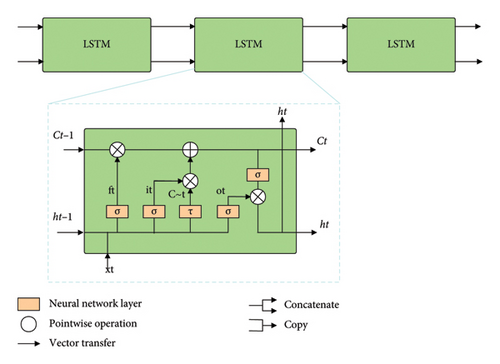
The neural network layer is used as a layer for learning. The pointwise operation performs point-by-point arithmetic operations. The vector transfer moves vectors in the direction of the arrows. The concatenate operation joins two vectors together. The copy operation duplicates a vector into two copies.
The core of LSTM is the cell state, and the long horizontal line across the top of the graph, which determines what information will be retained and what information will be forgotten, is denoted as Ct.
The LSTM implements three gate computations, the forgetting gate, the input gate, and the output gate, to protect and control the cell state.
3.3. AM
The CNN-LSTM model can effectively extract local global feature information; however, when dealing with longer sequences, there will still be some global correlation information that cannot be adequately captured.
Therefore, this paper introduces the SE AM as shown in Figure 2, which adaptively recalibrates the channel-based feature responses by explicitly modeling the interdependencies between channels. Specifically, the importance level of each channel is automatically acquired by learning, and then the useful features are promoted, and the features that are not very useful for the current task are suppressed according to this importance level, in order to further enhance the model’s representational and modeling capabilities when dealing with sequential data.
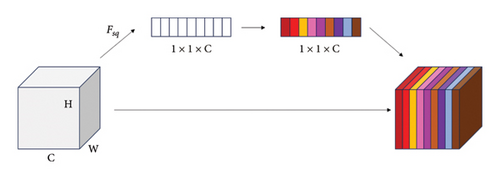
- •
Step 1. Squeeze compression, which turns the two-bit feature of each channel into a real number, which characterizes the global distribution of the response over the feature channels, and is implemented using global flat global pooling, and the formula for global average pooling is as follows:
() - •
Step 2. Excitation excitation, the importance of each channel is predicted through fully connected layers. The first fully connected layer has C∗SERatio neurons with 1 × 1 × C inputs and 1 × 1 × C × SERadio outputs, which act as a dimensionality reduction. The second fully connected layer has C neurons with an input of 1 × 1 × C × SERadio and an output of 1 × 1 × C.
- •
Step 3. Scale Scaling, consider the weights of the output of Excitation as the importance of each feature channel after feature selection, and then weight it to the previous features channel by channel by multiplication to complete the recalibration of the original features in the channel dimension.
3.4. AVOA
- •
Step 1. After the start of the iteration, the vultures are grouped according to their quality, the vultures corresponding to the optimal solution are placed in the first group and the vultures corresponding to the suboptimal solution are placed in the second group. The rest of the vultures are placed in the third group and the selection of the vultures to follow is carried out according to the following equation.
() -
where R(i) is the current individual learning, Best1 denotes the best bald eagle, Best2 denotes the second best bald eagle, and L is a user-defined parameter located in the range [0,1], which favors the population to search in the global range when L tends to 0 and favors the population to search in the local range when it tends to 1.
- •
Step 2. Calculate the population hunger level
-
When the vultures have low hunger, they have enough strength to go farther to find food, and if the vultures have high hunger now, they will become more aggressive and therefore approach the vultures that have food. Based on the above behavior, we use the following equations to calculate the vulture’s hunger level.
()() -
where F represents the vulture’s hunger; Ii denotes the current number of iterations; M denotes the maximum number of iterations; and h, z, and k1 are uniformly distributed random numbers between [−2, 2], [−1, 1], and [0, 1], respectively. w is a user-defined parameter controlling the probability that the algorithm will go into the exploratory mode in the final stage. When |F| ≥ 1, AVOA is in the exploratory phase, and when |F| < 1, AVOA is in the exploitation phase.
- •
Step 3. When a vulture searches for food, it first takes some time to judge the surrounding environment and then finds the food after a long flight. In AVOA, the specific formula for the exploration phase is shown as follows:
()() -
where Kp1 is the exploration parameter set in advance, P(i + 1) is the vulture position vector in the next iteration, X is a constant, k2 and k3 are random numbers between [0, 1], and ub and lb are the upper and lower bounds of the optimization search, respectively.
- •
Step 4. Development phase
-
When |F| is between 0.5 and 1, the AVOA enters the first stage of the development phase and executes the strategy of rotary flight, which is shown in the following equation:
() -
where Kp2, k4, and k5 are random numbers between [0, 1].
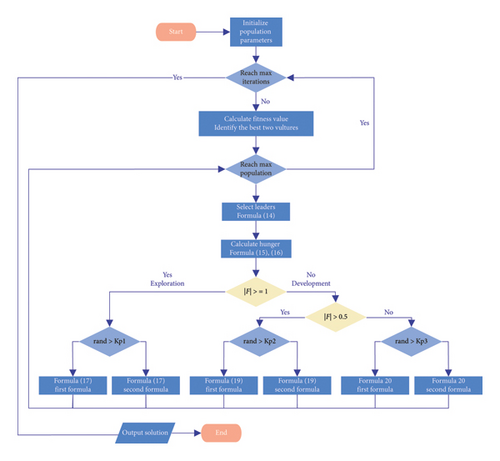
3.5. Predictive Model Construction
Combining MVMD, CNN, LSTM, AM, and AOVA algorithm, this paper constructs the combined model, and its structure and flow are shown in Figure 4.
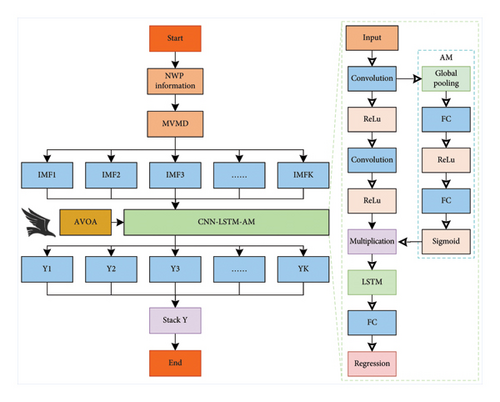
In order to mine the complex relationships in the weather data, the first step is to adopt the MVMD method to decompose the original weather data into submodalities with different frequencies. By adaptively decomposing the multivariate signals, the MVMD is able to efficiently extract the implicit features in the data, which can provide more stable input information for the subsequent prediction, thus better improving the accuracy.
To optimize the hyperparameters of the prediction model, we introduced the AVOA to adjust the learning rate and the number of nodes of the CNN and the LSTMN. AVOA is a heuristic algorithm based on the foraging behaviors of the vultures in the natural world, which has excellent global searching ability and convergence performance. The integration of AVOA with the CNN and LSTM facilitates the automatic search for the optimal model parameters, thereby enhancing the accuracy and the generalization capability of the prediction model.
Furthermore, the introduction of an AM into the prediction model is intended to enhance its accuracy. The AM has the capacity to selectively focus on the important parts of the input sequence that are relevant to the prediction task, thus enhancing the model’s ability to capture both local and global features.
4. Experimental Analysis
The programming language of the experimental environment in this paper is MATLAB, the version is MATLAB R2023b, the CPU is Intel i9-13900H, and the RAM size is 32.0 GB.
4.1. Data Preprocessing
The wind power numerical weather prediction (NWP) dataset [31] is provided by the Public Science Data Center for Basic Disciplines in China. These datasets record data pertaining to a wind farm in Jilin Province, China, over the course of a year, encompassing wind power and momentum fluxes, temperature, barometric pressure, wind speed, and other relevant variables, with a time step of 15 min. The total number of valid data points is 35,136, and part of the data is shown in Figure 5.
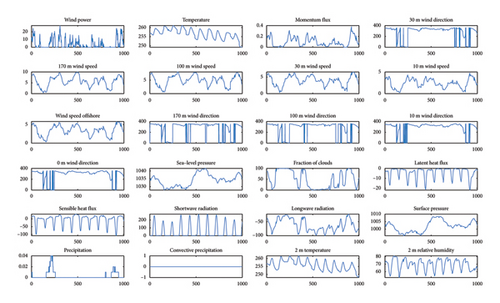
The correlation between each meteorological data and wind power was analyzed using the PCC method to obtain a heat map as shown in Figure 6.
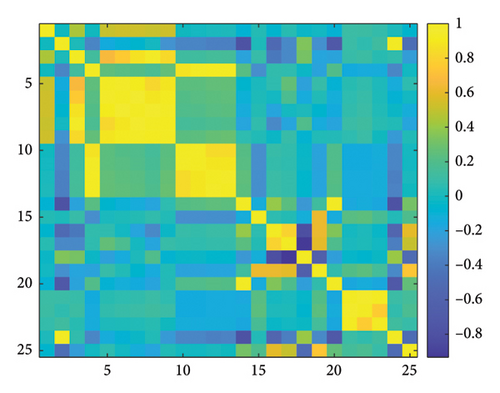
In the end, we chose the six meteorological data with higher correlation with wind power: momentum flux, 170 m wind speed, 100 m wind speed, 30 m wind speed, 10 m wind speed, and sea level wind speed.
4.2. Data Segmentation and Evaluation Indicators
In order to better adapt to the training of the model, we chose 1000 data in January and divided them into training set, validation set, and test set according to 8:1:1.
4.3. Decomposition Mode Selection (MVMD)
MVMD of weather data and predicted power is performed, with the center frequency method used to determine the optimal decomposition mode values. The decomposition mode center frequencies are displayed in Table 1. It is evident that excessive decomposition can lead to anomalous noise or mode overlap, while inadequate decomposition may result in undecomposed modes. The condition for determining mode overdecomposition is that adjacent modes possess analogous center frequency values. As can be seen in Table 1, this is the case for Modes 5 and 4. Therefore, the sequence is overdecomposed, and the optimal number of decompositions selected in this scheme is K = 4.
| K | IMF1 | IMF2 | IMF3 | IMF4 | IMF5 |
|---|---|---|---|---|---|
| K = 1 | 41.3211 | ||||
| K = 2 | 39.5649 | 6.7373 | |||
| K = 3 | 38.7504 | 2.5193 | 1.2365 | ||
| K = 4 | 38.2811 | 1.1224 | 2.7083 | 0.3019 | |
| K = 5 | 35.4812 | 3.1546 | 0.4450 | 1.0963 | 0.3417 |
The decomposition of momentum flux, 170 m wind speed, 100 m wind speed, 30 m wind speed, 10 m wind speed, sea level wind speed, and wind power are decomposed according to K = 4. The decomposition of each meteorological data set is illustrated in Figure 7.
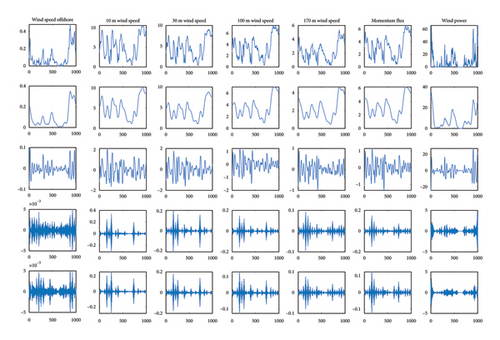
4.4. Determine the Time Step
It is important to note that varying results may be obtained when employing different time steps for prediction. To address this, the LSTM model is utilized as the fundamental model to ascertain the input time step. The range of the step is designated in [1, 5], and the outcomes are presented in Figure 8 for various time steps, respectively.
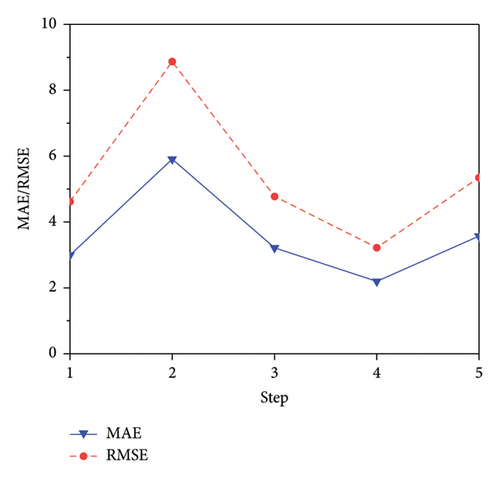
So the time step of the four models is chosen to predict the wind power.
4.5. MVMD and AM Validity Testing
In order to verify the effectiveness of MVMD and the AM, models were constructed for comparison with the prediction network. These comprised the AVOA-CNN-LSTM-AM and the MVMD-AVOA-CNN-LSTM models. The prediction results of these models are shown in Figure 9.
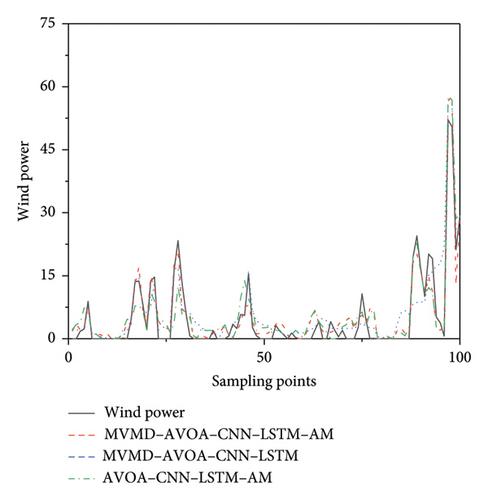
The results of the evaluation indicators are shown in Table 2.
| MVMD-AVOA-CNN-LSTM-AM | MVMD-AVOA-CNN-LSTM | AVOA-CNN-LSTM-AM | |
|---|---|---|---|
| MAE | 2.0467 | 2.7688 | 2.6534 |
| RMSE | 2.8329 | 4.4246 | 3.6845 |
Then, we compared the prediction errors of the MVMD-AVOA-CNN-LSTM-AM, AVOA-CNN-LSTM-AM, and MVMD-AVOA-CNN-LSTM models to analyze the effects of MVMD and AM. The results are shown in Figure 10.
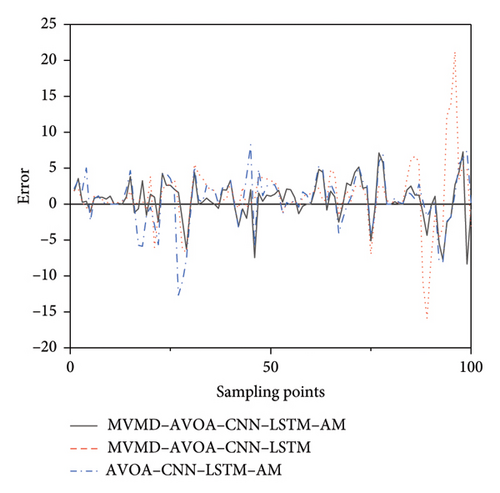
Subsequently, we conducted an in-depth analysis of the errors of the three models, and the results are shown in Figure 11. In ablation experiments, without the effect of the MVMD or AM mechanism, the errors are obviously more dispersed, and the results show that the MVMD-AVOA-CNN-LSTM-AM has a higher prediction accuracy.
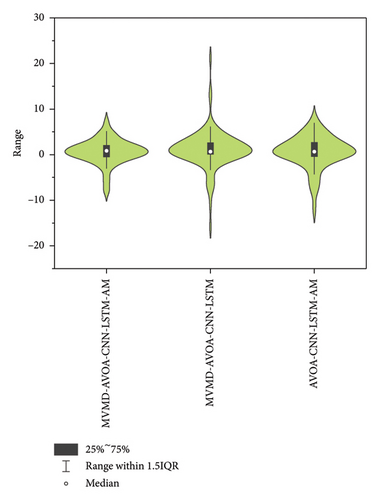
The error of MVMD-AVOA-CNN-LSTM-AM is relatively smaller and more concentrated. This proves that model fusion of MVMD and AM significantly improves the prediction results and improves the robustness and stability of the prediction model.
4.6. Comparison Experiment
To further verify the accuracy of the MVMD-AVOA-CNN-LSTM-AM prediction model, we compared it with BP model, GA-BP model, and MVMD-AVOA-CNN-GRU-AM model, whose prediction results are shown in Figure 12.
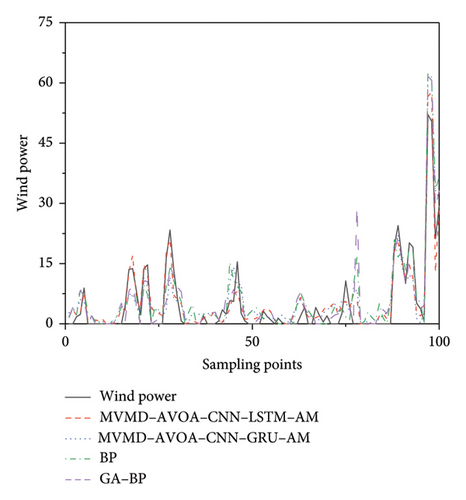
The results of the evaluation indicators are shown in Table 3.
| MVMD-AVOA-CNN-LSTM-AM | MVMD-AVOA-CNN-GRU-AM | BP | GA-BP | |
|---|---|---|---|---|
| MAE | 2.0467 | 3.0377 | 3.0586 | 2.6802 |
| RMSE | 2.8329 | 4.1536 | 4.3528 | 4.5094 |
Then, we analyzed the errors of four different models, and the error results are shown in Figure 13.
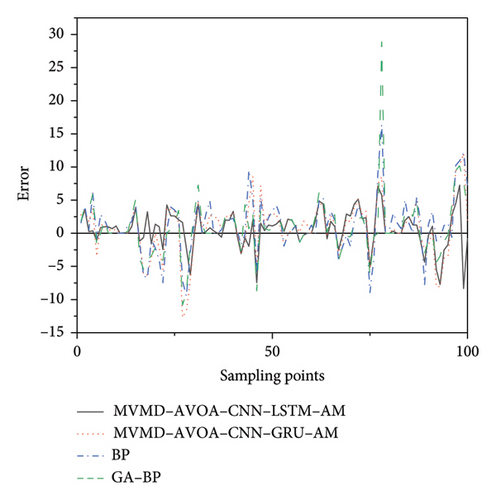
Subsequently, we conducted an in-depth analysis of the errors of the four models in the comparative experiment and obtained the violin diagram, as shown in Figure 14. The results show that the prediction accuracy of MVMD-AVOA-CNN-LSTM-AM is significantly higher.
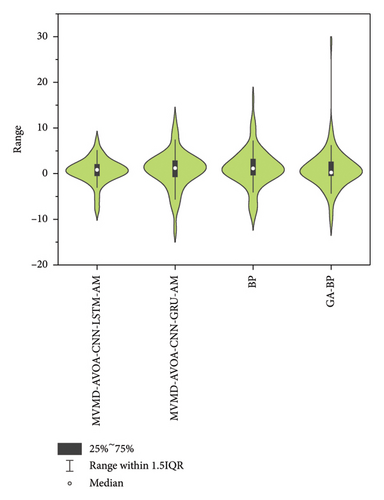
After comparison, we found that MVMD-AVOA-CNN-LSTM-AM has significantly better prediction results and is more stable and robust than models such as MVMD-AVOA-CNN-GRU-AM, BP, and GA-BP.
4.7. Universal Experiment
In order to verify the generalizability of the model, a test was conducted for each of the four seasons: spring, summer, autumn, and winter. The predicted MAEs for the four seasons are displayed in Figure 15.
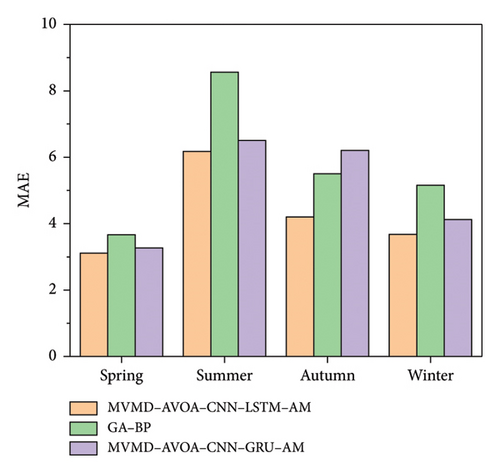
In verifying the robustness and stability of the model, 10 experiments were conducted for different models, and the MAE of the prediction results obtained is displayed in Figure 16.
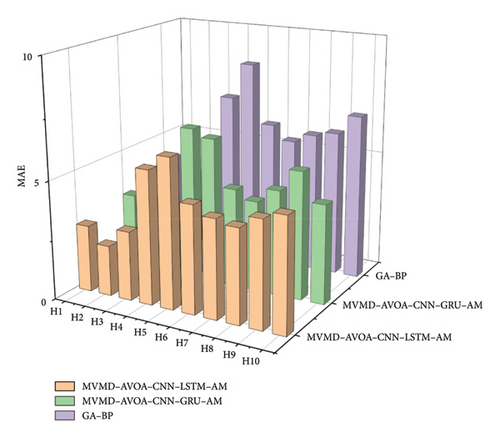
In a comprehensive comparison, we found that the MVMD-AVOA-CNN-LSTM-AM model has better prediction results and higher generalization and robustness of the model in multiple tests in all seasons.
5. Conclusions
In this paper, a novel wind power prediction model (MVMD-AVOA-CNN-LSTM-AM) is proposed, which integrates MVMD, the AVOA for leader–follower patterns, a CNN and a LSTM network, and an AM. Initially, the weather data are decomposed using the PCC method to extract the numerical MVMD algorithm that is more relevant to wind power to extract its main features. Subsequently, the AVOA is employed to enhance the learning rate, the number of nodes of the CNN, and the LSTM network to enhance the network’s capacity to process the weather data. Introducing an AM, which adaptively recalibrates channel-based feature responses by explicitly modeling interdependencies between channels and enhances the model’s prediction accuracy.
The model proposed in this paper can effectively deal with the nonstationarity and stochasticity of meteorological data, thus improving the accuracy and reliability of wind power prediction. The experimental results demonstrate that the model’s MAE is 2.0467, and the RMSE is 2.8329. A comparison with traditional prediction models reveals that the proposed model significantly improves prediction accuracy while exhibiting strong generalization capabilities and excellent model robustness. In the future, the team will continue to refine its work to enhance wind power prediction accuracy further. It is anticipated that this will provide a valuable reference point for related research in the future, including electricity price forecasting and power flow calculations.
Conflicts of Interest
The authors declare no conflicts of interest.
Funding
No funding was received for this research.
Open Research
Data Availability Statement
The data used to support the findings of this study are available at https://cstr.cn/16666.11.nbsdc.ky6qsoym.




